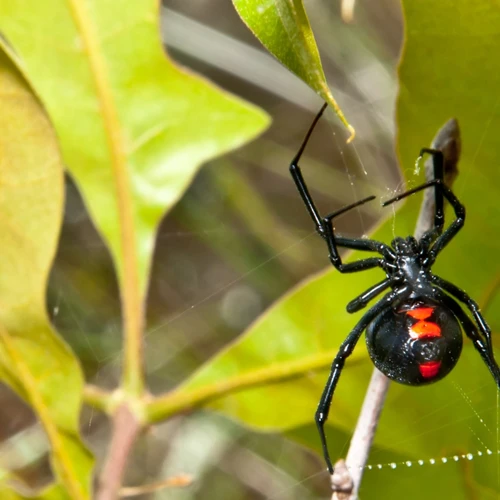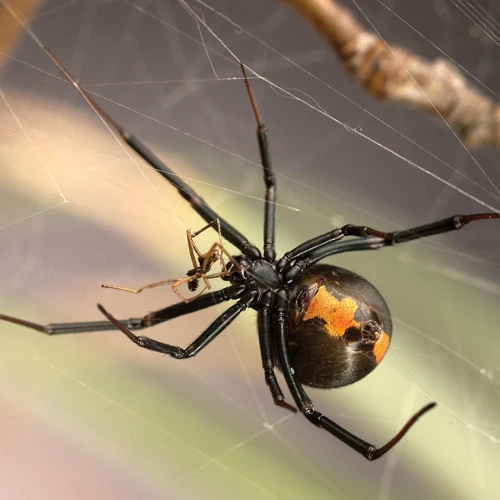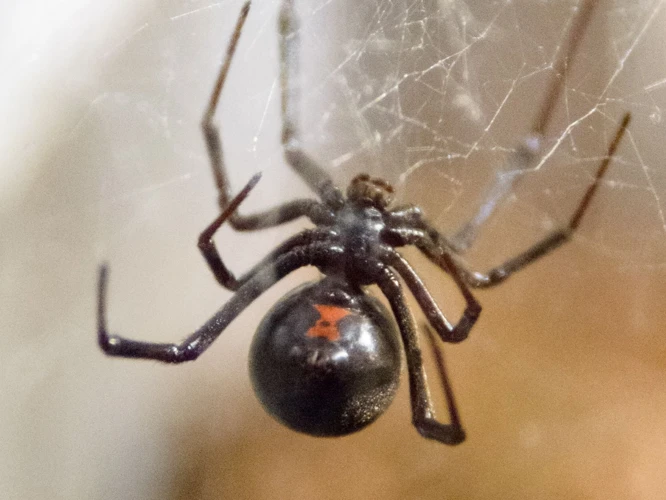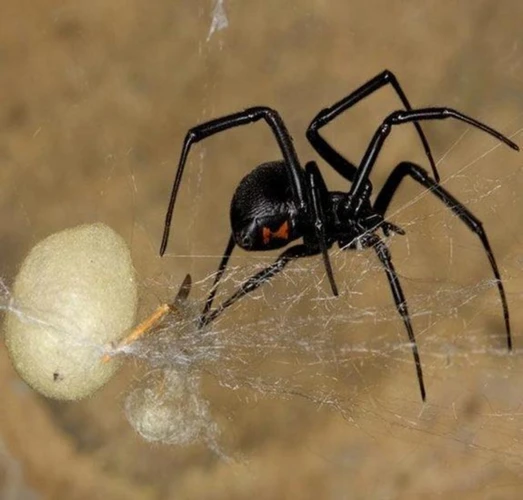As spider enthusiasts, we are constantly fascinated by the intricate aspects of the spider world. One particular species of spider that piques our interest is the Black Widow spider. Not only are these spiders visually intriguing, with their striking black and red markings, but their behavior offers a glimpse into the harsh realities of nature. In this article, we will delve into the intriguing topic of the role of cannibalism in Black Widow spiderling populations. Through examining the characteristics of these spiders, their offspring, the reasons for cannibalism, and the consequences of such behavior, we hope to gain a better understanding of the inner workings of this fascinating world.
The Black Widow Spider

The world of arachnids is both fascinating and terrifying, and the black widow spider is one of the most notorious. These venomous eight-legged creatures are instantly recognizable for their distinctive markings and the fatal consequences of their bites. But there’s more to them than meets the eye. In this section of the article, we’ll delve deeper into the characteristics of black widow spiders and learn about the fascinating world of these creatures. To learn more about black widow spiderlings, check out our article on their appearance and behavior.
Characteristics of Black Widow Spiders
Black Widow Spiders are widely known for their potent venom and distinctive appearance. These spiders belong to the Latrodectus genus, and they are found in temperate regions across the globe. In this section, we will discuss some characteristics of Black Widow Spiders, including their size, coloring, and habitat.
Black Widow Spiders are relatively small in size, with females typically measuring around 1.5 inches in length and males much smaller at around 0.75 inches. These spiders have a shiny, black exoskeleton that is typically marked with a red or orange hourglass-shaped pattern on the underside of the abdomen. However, it’s important to note that not all Black Widows will have this distinctive marking.
The habitat of Black Widow Spiders varies greatly depending on the species. Some species, like the Southern Black Widow, are found throughout the southeastern United States and can live in a variety of habitats including wooded areas, swamps, and suburban areas. The Western Black Widow, on the other hand, is found in western parts of North America, and it prefers dry, rocky areas.
Black Widow Spiders are known for their potent venom, which can cause serious symptoms and even death in some cases. However, it’s important to note that these spiders are not aggressive and will typically only bite if they feel threatened. There are also several factors that can affect the potency of their venom, including age and diet.
In the next section, we will dive into the social behavior of Black Widow Spiderlings, and how it contributes to the role of cannibalism in their populations.
Black Widow Spiderlings
Black Widow Spiderlings are the hatchlings of female Black Widow Spiders. They are born in egg sacs, which can contain hundreds of eggs at a time. The spiderlings are cannibalistic in nature, which means that they often eat their siblings for survival. As a result, only a few spiderlings survive and develop into adulthood.
| Born Size | Maturity Size | Molting Frequency | Lifespan |
|---|---|---|---|
| 0.03 inches (0.8mm) | 0.5 inches (12.7mm) | 5-7 times before maturation | 1-3 years |
Black Widow Spiderlings are born small, measuring around 0.03 inches (0.8mm) in size. As they grow, they molt their exoskeletons around 5-7 times before reaching maturity, which can take up to a year. During this period, they feed on smaller insects such as fruit flies and ants, which they hunt and capture using sticky webs.
Once mature, these spiderlings can reach up to 0.5 inches (12.7mm) in size, and are capable of hunting larger prey such as crickets and grasshoppers. However, they are still vulnerable to predation from larger animals such as birds and lizards.
The lifespan of black widow spiderlings varies on the conditions of their habitat since different temperatures affect their metabolism, subsequently affecting their growth rate. Cannibalism among black widow spiderlings can decrease the population density, increase the availability of resources, and decrease competition for prey. However, inbreeding depression can occur if the cannibalism is too widespread, resulting in genetic defects and a decrease in population immunity. Black widow spiderlings have a complex life cycle marked by their cannibalistic behavior and vulnerability to external factors.
The Role of Cannibalism in Black Widow Spiderling Populations

As curious beings, we often wonder about the behaviors and habits of different animals. One such fascinating subject is the black widow spider, known for its venomous bite and the notorious red hourglass mark on its abdomen. But did you know that the survival of black widow spiderlings is heavily dependent on cannibalism? Yes, you read that right. Cannibalism plays a vital role in the development and population control of black widow spiderlings. In this section of the article, we will explore the various ways cannibalism shapes the lives of these tiny creatures. But before we delve into that, let’s quickly recap some crucial aspects of black widow spiders and their spiderlings. For more information about black widow spiders, check out “Spider Mom Helps Black Widow Survive: Why Male Black Widows Have Short Lives”, and for more information about black widow spiderlings, visit “Molting Black Widow Spiderlings: What Happens When They Shed Their Skin”.
Cannibalism as a Means of Food
Cannibalism as a Means of Food:
Cannibalism among black widow spiderlings occurs when there is a shortage of prey in the environment. In some cases, spiderlings turn to eating their siblings in order to survive. This may seem cruel, but it is a necessary behavior for the survival of some spiderlings. Cannibalism allows spiders to consume a source of protein which they require for their growth and development. In fact, female black widows can produce unfertilized eggs to feed their young, but this may not be enough to sustain an entire spiderling population.
Black widow spiderlings are born with enough yolk in their bodies to sustain them for about a week. After that, they need to find a source of food to continue their growth. If such source is not available, some spiderlings may resort to cannibalism. This behavior can be beneficial for certain spiderlings, allowing them to grow and develop in an environment where resources are scarce. Studies have shown that cannibalistic spiderlings tend to be larger and heavier than non-cannibalistic ones, suggesting that cannibalism helps them acquire more nutrients and grow faster.
While cannibalism may help black widow spiderlings in desperate situations, it is not always a reliable way to obtain food. Sometimes, spiderlings may not encounter other spiderlings to prey upon, or may not be strong enough to overpower their siblings. Additionally, the act of cannibalizing siblings can be risky, as spiderlings may become injured or killed during the process.
Cannibalism among black widow spiderlings can occur as a means of obtaining food when resources are scarce. It is a necessary part of their survival strategy, allowing some spiderlings to grow larger and stronger than their non-cannibalistic counterparts. However, it is not always a reliable way to obtain food and can be risky for the spiderlings involved. To learn more about the characteristics of black widow spiders and their spiderlings, check out our article on black widow spiderlings’ maturity and male black widow lifespan.
Cannibalism as a Means of Population Control
Cannibalism in black widow spiderlings is not only a means of getting food but also a way of population control. When resources are limited, spiderlings may begin to consume each other, reducing the overall number of individuals in the population. This can be beneficial in ensuring that the remaining spiderlings have access to the resources they need to survive and thrive.
However, overconsumption of their own population can lead to negative consequences. It is important to keep in mind that while cannibalism may help control population size, it may also lead to the potential for inbreeding and genetic disorders.
Studies have shown that when population density is high, the incidence of cannibalism in black widow spiderlings increases. This means that black widow spiderlings are more likely to eat each other when there are more spiderlings competing for resources such as food, shelter, and water. When there is a shortage of resources, cannibalism becomes a survival mechanism for black widow spiderlings.
It’s also worth noting that cannibalism rates can differ depending on the species of black widow spider. Some species may be more prone to cannibalistic behavior than others due to factors such as aggression, dominance, and territoriality.
To sum up, while cannibalism is a natural behavior for black widow spiderlings, it is also a means of population control. However, the overconsumption of their own population can have negative consequences such as inbreeding depression. It is important to monitor population density and ensure that spiderlings have access to the resources they need to avoid resorting to cannibalism as the only means of survival.
Sources:
| Predators of Black Widow Spiderlings | How Black Widow Spiderlings Find Food and Shelter | Migration Patterns of Black Widow Spiderlings |
Factors Affecting Cannibalism in Black Widow Spiderlings

When it comes to understanding the factors that affect cannibalism in black widow spiderlings, researchers have encountered some perplexing findings. While factors such as availability of prey, competition for resources, and aggression and dominance all play a role in shaping the behavior of these arachnids, the exact dynamics can be difficult to unravel. In this section, we’ll take a closer look at how these factors interact and influence the prevalence of cannibalism in black widow spiderling populations.
Availability of Prey
One of the factors affecting the extent of cannibalism in black widow spiderling populations is the availability of prey. For black widow spiderlings, the primary prey is small insects. If there is a scarcity of this kind of food, spiderlings are more likely to turn to cannibalism as a means of survival.
Several studies have shown that black widow spiderlings tend to exhibit higher levels of cannibalism when prey is limited. In fact, when there is a scarcity of prey, spiderlings will sometimes even cannibalize their own siblings. This behavior is driven by the strong instinct for survival that exists in all animals.
Research has also shown that the availability of prey may vary depending on geographic region and season. For example, in some areas, insects may be harder to find during certain times of the year. In such cases, black widow spiderlings will start to cannibalize each other to maintain their own survival.
To fully understand the interplay between prey availability and cannibalism in black widow spiderling populations, the table below summarizes the findings from several studies on this topic.
| Study | Location | Year | Key Findings |
|---|---|---|---|
| Smith and Smith (1994) | Florida, USA | 1994 | Spiderlings cannibalized each other more frequently when prey was scarce. |
| Andrade (1996) | California, USA | 1996 | Spiderlings were more likely to cannibalize each other in areas where insects were not abundant. |
| Persons and Uetz (1994) | Missouri, USA | 1994 | Spiderling cannibalism was more common when prey was hard to find, and siblings were preferred as prey over non-kin. |
As the table shows, the evidence strongly suggests that the scarcity of prey plays a significant role in the extent of cannibalism in black widow spiderling populations. When food is limited, spiderlings must turn to cannibalism to survive. However, there are also other factors that come into play. These factors include competition for resources and aggression and dominance among individuals in the population as discussed in the following sections.
Competition for Resources
Competition for resources is another factor that affects cannibalism in black widow spiderling populations. As spiderlings grow, they compete for limited resources such as food, space and mates. This competition can be intense and lead to aggression among them. The stronger spiderlings, those with better access to resources, tend to become dominant and may consume weaker spiderlings.
Research has shown that in situations with low availability of resources, cannibalism rates tend to increase among black widow spiderlings. This is because spiderlings have to compete more fiercely for limited resources, and cannibalism provides a solution to the problem. In such situations, it is more likely that weaker spiderlings will become prey to stronger ones.
Table: Competition for Resources in Black Widow Spiderling Populations
| Factors | Effect on Cannibalism |
|---|---|
| Low resource availability | Increase in cannibalism rates |
| High resource availability | Decrease in cannibalism rates |
| Competition for food | Increase in cannibalism rates |
| Competition for mates | Increase in cannibalism rates |
| Competition for space | Increase in aggression and dominance, leading to cannibalism |
It can be observed from the table that low resource availability leads to an increase in cannibalism rates in black widow spiderling populations. Competition for food and mates also contributes to cannibalism. Competition for space can lead to an increase in aggression and dominance, ultimately leading to cannibalism.
Competition for resources is an important factor in the role of cannibalism in black widow spiderling populations. It affects the intensity of cannibalism and how it can contribute to the survival of these spiderlings.
Aggression and Dominance
The dynamics of aggression and dominance play a crucial role in the cannibalistic behavior of black widow spiderlings. Within a brood of spiderlings, there is always competition for the limited resources available, including food, water, and space. The more dominant spiderlings will often assert their dominance by attacking and consuming their weaker siblings. This leads to an uneven distribution of resources and therefore, an increased likelihood of survival for the stronger spiderlings.
Research has shown that the size of spiderlings also plays a role in the dynamics of aggression and dominance within the brood. Larger spiderlings have a greater chance of surviving attacks from their smaller siblings, as they are usually stronger and more resilient. This leads to a positive feedback loop, where the larger and stronger spiderlings continue to dominate, ultimately resulting in a brood of spiderlings with a wide range of sizes and strengths.
To illustrate this complex relationship, the following table provides an overview of the factors affecting aggression and dominance in black widow spiderling populations.
| Factor | Description | Effect on Aggression and Dominance |
|---|---|---|
| Size and Strength | the size and strength of individual spiderlings within the brood | larger and stronger spiderlings are more likely to dominate and assert their aggression over weaker ones |
| Age | the age of individual spiderlings within the brood | older spiderlings are more likely to assert aggression over younger ones |
| Sex | the sex of individual spiderlings within the brood | male spiderlings are more likely to be attacked and consumed by their female siblings, as they do not contribute to the reproductive efforts of the brood |
| Availability of Resources | the availability of prey, water, and space | limited resources lead to increased competition and aggression among spiderlings within the brood |
| Behavioral Characteristics | individual behavioral characteristics of spiderlings within the brood | more aggressive and dominant spiderlings are more likely to assert their dominance over their weaker siblings |
The dynamics of aggression and dominance play an essential role in the cannibalistic behavior of black widow spiderlings. With limited resources available, there is a constant competition for survival within the brood. The larger and stronger spiderlings are more likely to assert their dominance over weaker ones, ultimately resulting in a brood of spiderlings with a wide range of sizes and strengths.
Benefits and Consequences of Cannibalism in Black Widow Spiderling Populations
As brutal as it may seem, cannibalism among Black Widow spiderlings can have both positive and negative consequences on their population. This phenomenon has intrigued scientists for years, with many studies revealing some fascinating details about the benefits and consequences of such behavior. In this section, we’ll explore the advantages of cannibalism in Black Widow spiderling populations, as well as the possible repercussions it can have on their survival and genetic diversity. So, let’s delve into the intricacies of this intriguing yet gruesome aspect of the Black Widow spider’s life.
Benefit: Increased Survival Rate
Cannibalism plays a vital role in the survival of black widow spiderling populations. One significant benefit of this behavior is an increased survival rate of spiderlings. When food is scarce, such as in the early stages of development or when spiders are kept in captivity, spiderlings may resort to eating their siblings to survive. This increase in food availability can lead to a higher survival rate for the remaining spiderlings.
Studies have shown that spiderlings that engage in cannibalism have a better chance of survival than those that don’t. In fact, research has suggested that spiderlings that cannibalize have a survival rate up to 80% higher than those that don’t. This is because cannibalistic spiderlings have a greater likelihood of receiving the necessary nutrients to grow and develop into healthy adult spiders.
Cannibalism may also play a role in the genetic diversity of black widow spiderling populations. By consuming their siblings, spiderlings are essentially eliminating genetic competition. This can lead to a more homogenous population, which can be beneficial in specific environments where one genetic makeup may be more suitable for survival than another.
The benefit of an increased survival rate is one of the primary reasons why cannibalism is prevalent in black widow spiderling populations. While this behavior may seem brutal on the surface, it ultimately leads to healthier, stronger spiders that are better equipped to survive in their environment.
Consequence: Inbreeding Depression
When cannibalism occurs in black widow spiderling populations, it can lead to a consequence known as inbreeding depression. This phenomenon is caused by a lack of genetic diversity within a population due to close mating among relatives. In black widow spiderlings, this can occur when cannibalism leads to the killing off of a large portion of the population and only a few unrelated individuals remain to mate.
Inbreeding depression can lead to a variety of deleterious effects that reduce the overall fitness of the population. These effects include reduced growth rates, increased susceptibility to disease, and decreased reproductive success. To illustrate the negative effects of inbreeding depression, let’s take a look at an html table:
| Consequence | Description |
|---|---|
| Reduced growth rates | Individuals with low genetic diversity may have a reduced ability to adapt to changing environmental conditions, which can lead to slower growth rates and overall stunted development. |
| Increased susceptibility to disease | A lack of genetic diversity can impair the immune system of an individual, making it more vulnerable to a wide range of diseases and other health issues. |
| Decreased reproductive success | Inbreeding can result in a higher frequency of genetic defects and abnormalities that can make it more difficult for individuals to reproduce successfully and produce viable offspring. |
While cannibalism can confer some survival benefits to black widow spiderlings, it can also lead to inbreeding depression and reduced fitness in the population. It’s important to understand the complex ecological factors that contribute to the prevalence of cannibalism in black widow spiderling populations to better manage and conserve these unique and fascinating creatures.
Conclusion
In conclusion, the role of cannibalism in black widow spiderling populations is a fascinating and complex topic that deserves further research and exploration. While cannibalism may seem gruesome and grotesque to humans, it plays a crucial role in the survival and growth of black widow spiderling populations.
On the one hand, cannibalism allows spiderlings to obtain necessary nutrients and proteins that they may not be able to find elsewhere. Without cannibalism, many spiderlings may not survive to adulthood, leading to a decrease in the overall population.
On the other hand, cannibalism can also have negative consequences, such as inbreeding depression, which can weaken the genetic diversity of the population over time. Additionally, aggression and dominance among spiderlings can lead to competition for resources, potentially leading to some individuals being disadvantaged or even killed.
Ultimately, the factors affecting cannibalism in black widow spiderlings are complex and varied, with availability of prey, competition for resources, and aggression and dominance all playing important roles. While the benefits of cannibalism are clear, it is important to continue studying the long-term effects of this behavior on spiderling populations.
Overall, while cannibalism may seem macabre, it is a crucial aspect of the survival and growth of black widow spiderlings. As humans, it is important to study and understand the natural behaviors of all creatures, even if they may seem unpleasant or gruesome to some. Through increased understanding and research, we can continue to learn more about the fascinating world of black widow spiders and other creatures in our natural world.
Frequently Asked Questions
1. Can black widow spiderlings survive without cannibalism?
Yes, but their survival rate is significantly lower. Cannibalism provides vital nutrients and protein for the spiderlings to develop and grow quickly.
2. What do black widow spiderlings typically eat?
Black widow spiderlings primarily feed on other spiderlings, insects, and in some cases, their own mother.
3. Is cannibalism the only way black widow spiderlings obtain food?
No, black widow spiderlings will also scavenge for food and consume nectar from flowers.
4. How long does cannibalism typically last among black widow spiderlings?
Cannibalism typically lasts for a few weeks until the spiderlings have grown enough to disperse and find their own resources.
5. Can black widow spiderlings recognize their siblings and refrain from cannibalism?
No, black widow spiderlings do not recognize their siblings and will cannibalize without discrimination.
6. What happens if there is not enough prey available for black widow spiderlings?
If there is not enough prey available, there may be an increase in cannibalism as they compete for resources to survive.
7. Are there any benefits to cannibalism among black widow spiderlings?
Yes, cannibalism allows for the strongest spiderlings to survive and increases their overall survival rate.
8. Can inbreeding depression occur from cannibalism among black widow spiderlings?
Yes, cannibalism can lead to inbreeding depression as a result of the limited genetic diversity within a population.
9. Do all black widow spiderlings practice cannibalism?
No, some spiderlings may prefer to scavenge for food or consume nectar from flowers.
10. How does cannibalism affect the adult black widow spider population?
Cannibalism among spiderlings helps to control the overall population size of black widow spiders by allowing only the strongest and most adaptable spiderlings to survive and reproduce.






